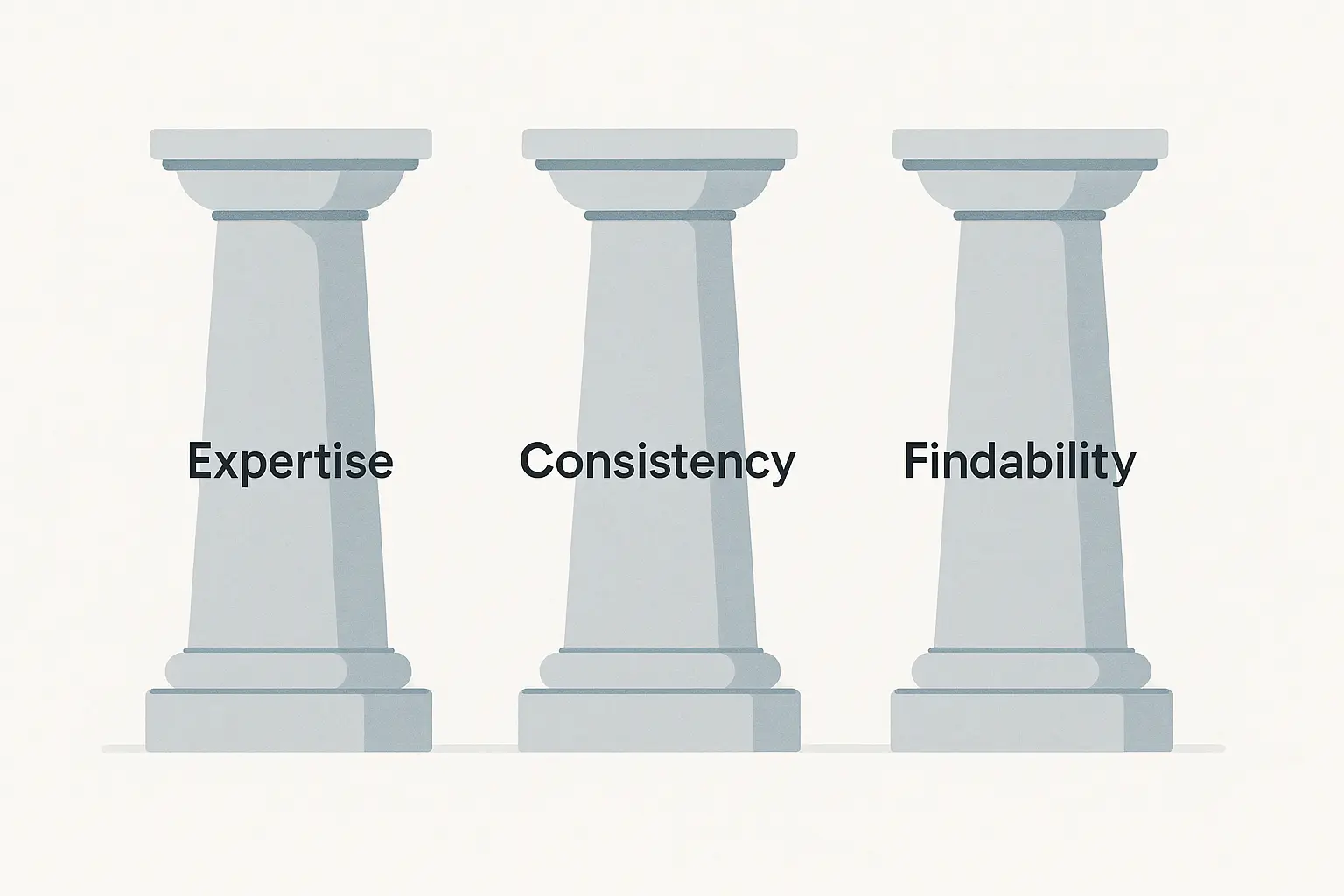
From Invisible to Influential: How Strategic Content Drives Sustained Business Growth
May 23, 2025
Content Marketing & CopywritingIn a noisy world, becoming noticed isn't about raising your voice — it's about being there with depth. This post examines how purposeful content works to turn companies from being ignored to being trusted leaders — not in one night, but for the long term.

Here's something I've noticed in thousands of businesses: the ones that endure aren't the noisiest ones. They're the ones that people actually listen to.
Think about the cybersecurity expert who knows everything about protecting data but can't be found when business owners Google "how to secure my network." Meanwhile, their competitors are writing mediocre blog posts and ranking for everything.
It's a common story: brilliant professionals with decades of experience, watching less knowledgeable competitors get all the attention simply because they're more visible online. Here's the thing—knowledge locked in someone's brain only benefits the folks in that room. But when that same knowledge gets disseminated through smart content, it can benefit thousands of individuals making more informed decisions.
What sets invisible apart from influential often boils down to one factor: sharing what you already understand.
Why Most Content Fails (And Why Yours Doesn't Have To)

Walk through any online space today and you'll find the same thing: content made for machines, not people. Keyword-filled articles that mean nothing. Engaging posts that engage nobody. Content designed to deceive algorithms rather than assist people. It's tiresome and it doesn't work.
The companies that I see thriving are responding to authentic questions from real people. They're using their sales call conversations, support requests, and client meetings and translating them into meaningful content.
When your content reaches someone at just the right moment—and helps them solve a real problem—you go from invisible to influential. That’s the power of strategic content.
The Three Things That Truly Build Influence

Having seen businesses change their whole direction by using content, I've observed three things they do:
1. They Share Their Expertise (Not Their Opinions)
Thought leadership is not the same as true leadership. True leaders educate. They simplify tough challenges. They expose frameworks they've learned over decades of experimentation.
I've watched accountants describe tax strategy as if they're chatting with a neighbor. I've observed software consultants make technical horrors into plain how-to manuals. These are not folks attempting to be witty—they're folks sharing their knowledge.
Your customers already believe you know what you're doing. Your content merely makes more folks aware of it.
2. They Show Up Consistently
Trust isn't built in a day. It's built over dozens of helpful interactions, each one reinforcing that you know what you're talking about.
The most successful content creators I know aren't necessarily the most talented writers. They're the ones who publish every Tuesday at 9 AM for two years straight. They're the ones who answer the same client questions in blog form that they answer in person.
Consistency trumps perfection every time.
3. They Make It Easy to Find
The world's greatest content is useless if nobody can find it. This is about knowing how your dream clients look for information, the language they use, and where they turn when they need assistance.
It also implies establishing relationships between your content. When someone learns about Problem A, are they able to easily discover your solution to related Problem B? When they complete your guide, do they have an idea of what to read next?
This isn't search engine manipulation. It's designing a coherent flow for folks to follow.
What This Actually Looks Like
Let's consider that cybersecurity expert I was talking about. Here is what a strategic strategy would be like:
They begin with the question, "What are my prospects constantly asking me?" They create a list of twenty typical questions. And then they answer one every two weeks, the same way they would answer it on a consultation call. No complicated language. No keyword jumping through hoops. Simply straightforward instructions for enabling two-factor authentication as if explaining it to a neighbor.
Three months pass and those articles begin to rank. Six months pass and other websites link to them. A year passes and journalists reach out for expert opinion.
The expertise has been there all along. Strategic content just makes it discoverable.
How to Begin (Without Overwhelming Yourself)
I know what you're thinking. "This sounds wonderful, but I scarcely have time to operate my business, never mind write about it."
Here is the thing: you're already producing content. Every client phone call, every FAQ you respond to, every solution you engineer—that's all content that just needs to be recorded.
Begin here:
Look at what you already have. Check your email. What do clients ask for over and over? What explanations do you catch yourself repeating over and over? There's your first five blog posts.
Create a simple plan. Choose two topics you could write about in your sleep. Commit 30 minutes every other week to writing about one of them. That's it. No need for an elaborate editorial calendar or content themes.
Speak as you think. Think you're going to tell a client about this over coffee. Write using the same tone, the same examples, the same detail. If you would sketch out a diagram on a napkin, add a photo to your post.
Stick it where people can see it. This involves simple SEO—writing using the words clients use, structuring your content sensibly, and ensuring your site loads quickly. Nothing complicated.
Put it out there where your people are. If you're on LinkedIn, post it there. If you have a monthly newsletter, feature it. If you're speaking at industry conferences, refer to it.
The aim isn't to be a content marketing machine. It's to get your expertise out there in front of the people who need to see it.
Why This Works Better Than Everything Else
This is my favorite thing about content: it's the one form of marketing that improves over time.
Have a campaign run an ad, and the traffic vanishes when you turn off the faucet. Write a useful blog post, and it can bring in the right type of people for years to come. I have clients still pulling in leads from blog posts they created three years ago.
This isn't about generating more work for yourself. This is about getting your existing expertise to do more. Each time you fix one problem for one client, you can fix it for hundreds more.
The companies that get this aren't surviving—They're becoming the go-to choice in their industry. And they're doing it by sharing what they already know, just more strategically.
Making This Strategy Work for Your Business
The secret to being successful with content isn't emulating someone else's game plan—it's being aware of your specific place in the marketplace and doing what makes you uniquely valuable.
Begin by actually listening. To your industry discussions, to the recurring questions in your arena, to the holes in knowledge that your dream clients are wrestling with. What insights do you bring that others don't? What issues do you solve in a different way?
Then concentrate on developing material that sounds like it's coming from you. Material that sounds like you'd actually describe it (because genuine voice gets heard louder than glib corporate jargon). Material that draws in the correct individuals and makes you someone worth hearing.
The distribution, optimization, and strategy elements are skills that can be learned. But they work most effectively when they're constructed around content that truly represents your expertise and point of view. That's what distinguishes converting content from content that exists.
Ready to break out of being the best-kept secret in your business niche? Strategic content could be just the ticket to creating influence out of your expertise. The companies that get it right don't merely survive but become the go-to choice in their market.